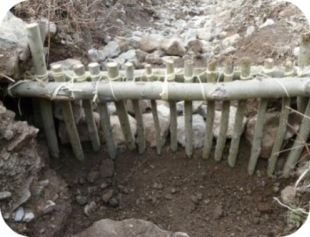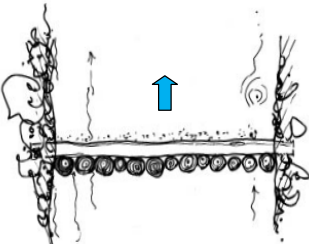Application: Bridges, canals, drainage, dykes, embankments, roads, footpaths, wastewater treatment plants
Description: A palisade is a wall consisting of living, uniform stakes of live material driven into the ground (one third of their length), close to each other to form a palisade. Palisades reduce slopes in gullies and tributaries, encourage deposition of sediments especially in fine soils, and form a strong barrier to reinforce the slope especially once cuttings have taken root. Palisades are used to promote deposition in rills, V-shaped gullies and rehabilitation in fine soils (clay, sand, loess, loam).
Contribution to climate resilience: Palisades reduce erosion in gullies and tributaries by reducing their slope, encouraging deposition of sediments and providing slope reinforcement. By these means they increase the resilience of streambanks to extreme climatic events. Because they are developed using local labour and locally available materials, they require less energy to produce, are far more sustainable, and can be applied quickly.
Supplementary sources of information:
https://www.nswa.ab.ca/sites/default/files/Lives%20staking%20%26%20joint%20planting.pdf
http://www.cesvi.org/aaa-root/o/Erosion%20control_Tajikistan2013.pdf
http://lib.icimod.org/record/27708/files/Chapter%204%20Bioengineering.pdf
Background image credit: ICEM
This resilience-building measure is sourced from the Water Resource Adaptation Guide (2019) published by the National Council for Sustainable Development at the Ministry of Environment in Cambodia. The full Guide is available to download at URL https://ncsd.moe.gov.kh/sites/default/files/2019-10/Water%20Resources%20Adaptation%20Guide_March%202019_En.pdf


